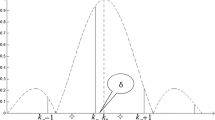Abstract
To improve the efficiencies of the traditional spectrum reconstruction techniques, an improved spectrum reconstruction technique (ISRT) based on chirp rate modulation (CRM) is proposed. With the help of a CRM operation, a reconstructed wideband signal with a narrow pulse width can be obtained. Compared with the traditional time domain spectrum reconstruction technique (TSRT), ISRT is less time-consuming since much less samples are needed. Compared with the traditional frequency domain spectrum reconstruction technique (FSRT), the reconstructed signal is a chirp signal, which has no limitation on the subsequent imaging algorithm. What is more, processing steps of ISRT are optimized, and the computational burden is less than that of TSRT and FSRT. Both simulation results and real data processing have verified the validity of ISRT.
创新点
本文提出了一种改进的频谱重建方法。此方法仅在频域就可以对各子带信号进行精确的频谱重建, 这大大降低了频谱重建的运算量。同时, 此方法通过对匹配滤波后的子带信号进行调频率调制来降低频谱重建后宽带信号的点数, 这又大大提高了此方法的效率。因此, 相对于传统的时域和频域频谱重建方法, 此方法具有更高的效率, 并且其重建得到的宽带chirp信号具有较少的点数, 这有利于降低后续SAR成像处理的运算量。
Similar content being viewed by others
References
Lin Y G, Zhang B C, Jiang H, et al. Multi-channel SAR imaging based on distributed compressive sensing. Sci China Inf Sci, 2012, 55: 245–259
Liu Y, Wu Q S, Sun G C, et al. Parameter estimation of moving targets in the SAR system with a low PRF sampling rate. Sci China Inf Sci, 2012, 55: 337–347
Fan B K, Ding Z G, Gao WB, et al. An improved motion compensation method for high resolution UAV SAR imaging. Sci China Inf Sci, 2014, 57: 1–13
Wehner D R. High-Resolution Radar. Boston: Artech House, 1994. 217–233
Lord R T, Inggs M R. High range resolution radar using narrowband linear chirps offset in frequency. In: Proceedings of the 1997 South African Symposium on Communications and Signal Processing, Grahamstown, 1997. 9–12
Wilkinson A J, Lord R T, Inggs M R. Stepped-frequency processing by reconstruction of target reflectivity spectrum. In: Proceedings of the 1998 South African Symposium on Communications and Signal Processing, Cape Town, 1998. 101–104
Levanon N. Stepped-frequency pulse-train radar signal. IEE Proc-Radar Sonar Navig, 2003, 149: 198–209
Deng Y K, Zheng H F, Wang R, et al. Internal calibration for stepped-frequency chirp SAR imaging. IEEE Geosci Remot Sens Lett, 2011, 6: 1105–1109
French A. Improved high range resolution profiling of aircraft using stepped-frequency waveforms with an S-band phased arrayed radar. In: Proceedings of IEEE Conference on Radar, Verona, 2006. 24–27
Berens P. SAR with ultra-high range resolution using synthetic bandwidth. In: Proceedings of IEEE International Geoscience and Remote Sensing Symposium, Hamburg, 1999. 1752–1754
Nel W, Tait J, Wilkinson A, et al. The use of a frequency domain stepped frequency technique to obtain high range resolution on the CSIR X-band SAR system. In: Proceedings of 6th Africon Conference in Africa, George, 2002. 327–332
Zeng T, Liu L S, Ding Z G. Improved stepped-frequency SAR imaging algorithm with the range spectral-length extension strage. IEEE J Sel Top Appl Earth Obs Remot Sens, 2012, 5: 1939–1404
Ding Z G, Gao W B, Liu J Y, et al. A novel range grating lobe suppression method based on the stepped-frequency SAR image. IEEE Geosci Remot Sens Lett, 2015, 3: 606–610
Sack M, Ito M R, Cumming I G. Application of efficient linear FM matched filtering algorithms to synthetic aperture radar processing. IEE Proc F-Commun Radar Signal Process, 1985. 45–57
Cumming I G, Wong F H. Digital Processing of Synthetic Aperture Radar Data: Algorithms and Implementation. Boston: Artech House, 2005. 5–76
Raney R K, Runge H, Bamler R, et al. Precision SAR processing using chirp scaling. IEEE Trans Geosci Remot Sens, 1994, 4: 786–799
Moreira A, Huang Y. Airbome SAR processing of highly squinted data using a chirp scaling approach with integrated motion compensation. IEEE Trans Geosci Remote Sens, 1994, 5: 1029–1040
Author information
Authors and Affiliations
Corresponding author
Rights and permissions
About this article
Cite this article
Gao, W., Ding, Z., Zhu, D. et al. Improved spectrum reconstruction technique based on chirp rate modulation in stepped-frequency SAR. Sci. China Inf. Sci. 58, 1–11 (2015). https://doi.org/10.1007/s11432-015-5329-3
Received:
Accepted:
Published:
Issue Date:
DOI: https://doi.org/10.1007/s11432-015-5329-3
Keywords
- chirp rate modulation (CRM)
- spectral efficiency
- improved spectrum reconstruction technique (ISRT)
- spectrum reconstruction
- stepped-frequency
- SAR




